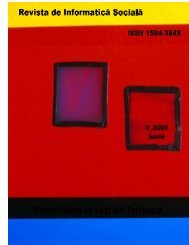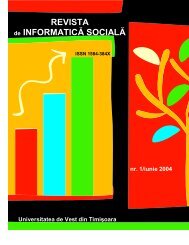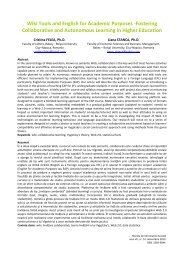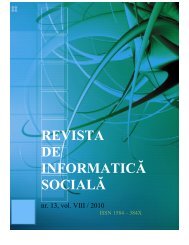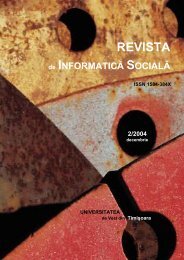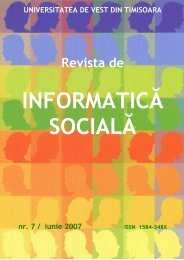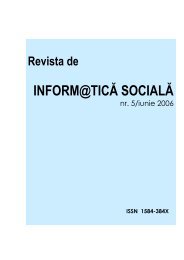web 2.0 and web 3.0 environments - Journal of Social Informatics ...
web 2.0 and web 3.0 environments - Journal of Social Informatics ...
web 2.0 and web 3.0 environments - Journal of Social Informatics ...
Create successful ePaper yourself
Turn your PDF publications into a flip-book with our unique Google optimized e-Paper software.
5. eLearning <strong>and</strong> <strong>Social</strong> Semantic Web Knowledge<br />
Management Tools <strong>and</strong> Approaches<br />
There are two main approaches for integrating Web <strong>2.0</strong> <strong>and</strong> Web <strong>3.0</strong> technologies: implicit<br />
<strong>and</strong> explicit. The main characteristic <strong>of</strong> implicit approach is the background usage <strong>of</strong> semantic<br />
<strong>and</strong> intelligent technologies whereas in explicit approaches Web <strong>2.0</strong> sites or portals propose<br />
semantic <strong>web</strong> tools, adapted for the usual user.<br />
5.1. Implicit approaches<br />
Implicit approaches are very useful for facilitating <strong>and</strong> automating learning content creation<br />
or usage. In [18] an approach for dynamically generating personalized hypertext relations<br />
powered by reasoning mechanisms over distributed RDF annotations is proposed. Several<br />
ontologies have been used: a domain ontology (describing the document space, the relations<br />
<strong>of</strong> documents, <strong>and</strong> concepts covered in the domain <strong>of</strong> this document space), a user ontology<br />
(describing learner characteristics), <strong>and</strong> an observation ontology (modeling different possible<br />
interactions <strong>of</strong> a user with the hypertext). For generating hypertext structures, presentation<br />
ontology has been introduced. As a result the approach generates a personalized conceptual<br />
context <strong>of</strong> learning resources which may be used for automatic learning resources selection.<br />
A Wiki is a medium for collaboration that allows many people to participate in the production<br />
<strong>of</strong> a long-term knowledge repository. It is excellent tool for collaborative learning in Web<br />
environment. St<strong>and</strong>ard Wiki’s drawback is his knowledge organization only on syntactic<br />
level. Semantic wikis combine the philosophy <strong>of</strong> wikis with the concepts <strong>and</strong> techniques <strong>of</strong><br />
the Semantic Web (i.e. enriching the data on the Web with well-defined meaning). Two main<br />
types <strong>of</strong> semantic wikis can be distinguished: text-centered (that enrich classical wiki<br />
<strong>environments</strong> with semantic annotations) <strong>and</strong> logic-centered (that use semantic wikis as a<br />
form <strong>of</strong> online ontology editors). Semantic MediaWiki [19], IkeWiki[19], SweetWiki [21],<br />
<strong>and</strong> HyperDEWiki [22] are examples <strong>of</strong> text-centered semantic wikis, whereas OntoWiki [23]<br />
<strong>and</strong> myOntology [24] are examples <strong>of</strong> logic-centered semantic wikis. In SweetWiki an OWL<br />
schema captures concepts such as wiki word, wiki page, forward <strong>and</strong> backward link, author,<br />
etc. This ontology is then used by an embedded semantic search engine (Corese). SweetWiki<br />
integrates a st<strong>and</strong>ard WYSIWYG editor (Kupu), extended to support semantic annotation<br />
based on "social tagging" Freebase, Knoodl [25], SWIRRL, <strong>and</strong> Twine [26] are <strong>web</strong><br />
applications that do not call themselves “semantic wikis" but exhibit many <strong>of</strong> their<br />
characteristic properties are some examples.<br />
5.2. Collaborative Web <strong>2.0</strong> based ontology building approaches<br />
<strong>and</strong> lightweight tools<br />
Ontologies are very important not only for searching <strong>and</strong> automatic information integration,<br />
but they are useful tool for knowledge underst<strong>and</strong>ing in the learning process. That is why we<br />
should consider them as important type <strong>of</strong> learning resource. As it is shown above, most <strong>of</strong><br />
the current methodologies <strong>and</strong> tools for building ontologies are intended for specialized<br />
knowledge engineers. The latest emerging approach in ontology building is to develop<br />
methodologies <strong>and</strong> tools for lightweight Web <strong>2.0</strong> based collaborative ontology construction or<br />
maturing.<br />
18



